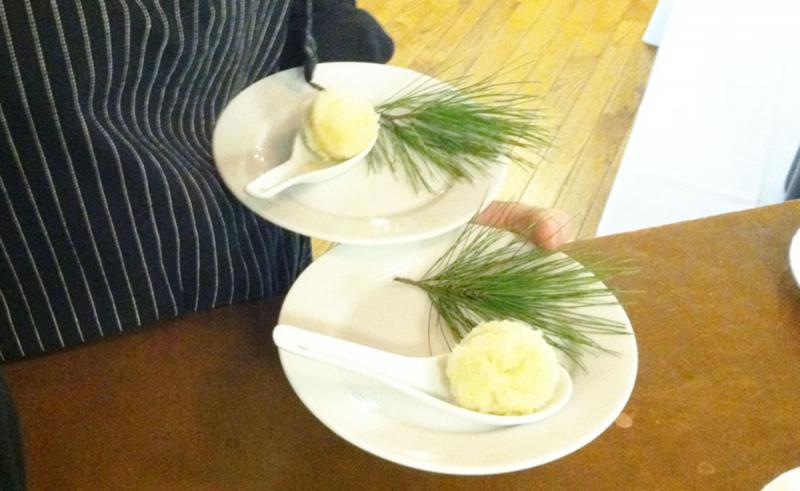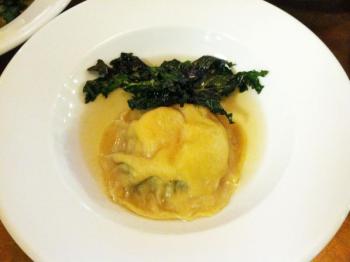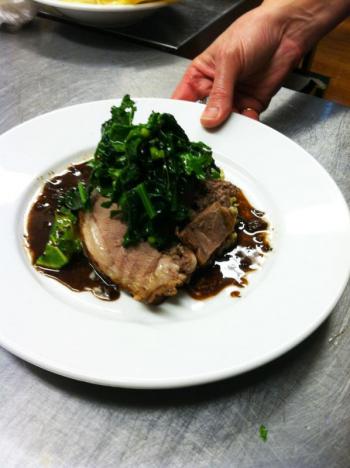LINCOLNVILLE – Ladleah Dunn is a sailor and a darn good cook. More importantly, she aims to not take the foodie industry in Maine so seriously or make it too precious. Her culinary adventures stem largely from her own small farm in Lincolnville; what’s ridiculous is how she makes it look so easy.
Even though snow covers the greenhouse and it seems as though we’ll never see green shoots poking from the ground ever again, there’s always something cooking at Sailor’s Rest Farm. It’s been awhile since we checked in with Ladleah Dunn, and you’d think winter would be her downtime, but she has been far from idle.
For more than a year, she has been working with recognized food expert Nancy Harmon Jenkins doing recipe testing for Nancy’s new book on olive oil coming out next year. As a result of their association, Nancy and Ladleah collaborated on hosting a special fundraising dinner for the Maine Farmland Trust on March 3.
The beauty of this dinner was the self-imposed constraints Ladleah put herself under. “A late winter harvest” was the theme. With the exception of anchovies and olive oil, she was committed to prepare seven courses with everything made 100 percent from Maine ingredients.
“I love a challenge and at first I thought, no problem. As it got closer to the date, there was definitely an element of panic. All the things you take for granted — like sugar, black pepper, salt, etc., I couldn’t use regular sugar from the bag, for example. It had to a native sweet element from Maine, so preparing the meal took extra care and consideration with each step,” said Dunn.
Procuring the ingredients took more than a month to plan and spanned three days to collect, buying from Maine farmers and producers. “It’s not like going to Hannaford and getting your shopping done in an hour,” she laughed. “I am very lucky to have such a great network of food folks and in one instance, I worked with a farm in Belfast 50 days in advance to get radish sprouts.”
Jumping on an urban trend called a “pop-up” restaurant, where a high profile chef borrows someone’s commercial kitchen for one night to make a multi-course meal for numerous people — a Lincolnville store allowed Ladleah and her ersatz staff to use their commercial kitchen and space to serve 30 people.
At 4 p.m. that Sunday, the scene was set. The long tables were decorated with fresh produce representative of the season; kales, leeks, potatoes, eggs, apples, etc. Each course would be paired with its own wine, provided by Ladleah’s friend Rodney Winchell, a sommelier, who has appeared in previous columns.
To appreciate the full intensity of what went into each course, here’s a peek behind the scenes, in Ladleah’s own words.
Passed and stationary appetizers
We wanted to do fried Maine chicken livers with summer pickle and shallot petals because they have such a sweet and intense flavor along with corn meal clam fritters, which were one of the recipes Nancy will be featuring in her forthcoming cookbook, because they’re just so delicious. Sam Mudge, a farmer here in Lincolnville, produces the best corn meal I’ve ever had. With Maine shrimp at the peak of their season, the stationary centerpiece featured ceramic spoons of shrimp ceviche sprinkled with touches of toasted dulse and D'avignon radish with whipped butter and wood charred toasts.
First course
Bacon, Cornmeal Fried Smelts over Carrot and Parsnip Chips
This was a take on seasonal fish and chips. I’d gone around and around on this course, because it was the first impression, but I immediately thought smelts, because they’re running up the river right now. The smelts came from up-country; the bacon fat was rendered. The chips were hand-shaved and flash fried in a deep fryer.
Second course
Ravioli in Brodo
This is a traditional Italian dish, basically an egg yolk in a large ravioli surrounded by a super rich broth. Our girls (their chickens) aren’t laying enough right now so we got them from a number of different small farmers. We separated the egg white from the yolk and carefully placed it into a handmade ravioli made from flour grown in northern Maine and milled in Skowhegan. We made a cheese filling with farm cheese from Rockport, wild-harvested chanterelle mushrooms we harvested the year before, and spinach grown by a friend of mine. You settle the unbroken yolk in the nest of cheese, close it up and boil in salty water. Then you serve in a bowl with this flavor-intensive brodo. It took a couple of days to render this broth, from what I like to call the “barnyard blend” of beef knuckles, pigs feet, lambs ribs and turkey carcass with a mirepoix, which is essentially, carrots, onions and celery. We garnished it with a crispy kale, that blended into the broth.
Third course
Intermezzo
My mom turned me on to this Swedish chef who is doing this back-to-the-land cook hipster thing where they only use native ingredients. So, we decided to pick a bushel of new growth white pine tips, and cook them down with a syrup of honey. Then, we extracted, blended and strained them. The honey produced around here is so flavorful, it’s almost overpowering, so I was up at 6:30 that morning, tasting it, noting it was too sweet. We had buckets full of maple sap from our own farm, so I just started diluting sap straight out of the tree into the mixture. Then I put in cider vinegar produced in Lincolnville and whipped it by hand in the ice cream maker until it had the right balance of what I was looking for.
Fourth course
Roasted Lamb On Cedar Boughs with Potatoes Dauphinoise
When I first learned we might be doing the dinner, I went straight to Maine Street Meats in Rockland, because I trust they were going to have exactly what we wanted. From them we got saddle of lamb from Northstar Farm in Windsor. A couple of days ahead, they allowed me to come into their kitchen and dress the lamb with a homemade “shmear” of butter, garlic, anchovies, sage, rosemary, and thyme before the butcher trussed it and vacuum packed it for a few days. The night of the dinner, we pan-seared it and roasted it on top of fresh-cut cedar boughs. Nancy felt very strongly that roasted lamb should be served with potatoes dauphinoise, which is like an au gratin. We used some of our potatoes that we grew, along with some celery root. One of our cooking mistakes ended up being a batch of heavy cream accented with buttermilk and chamomile that didn’t work as an ice cream, but resembled cheese and was incredible with the potatoes.
Fifth course
Cheese board and Salad
It’s actually a really nice way to settle the stomach after an intense feast to end with cheese and salad, rather than that be the first course. We served Hahn’s End Blue Velvet, (blue cheese), and St. David (a triple cream) and a York Hill goat cheese aged for one year. We served the cheese on pieces of slate that my husband specially cut. The accompaniments on the slate itself were candied cubes of ginger grown in Maine, cooked in honey, as well as cubes of pickled beets. We wanted something nutty with texture to go with the cheese, but there are no nuts native to Maine, so we smoked Maine sea salt in the smoker and added that to the Maine-grown rye crackers we made, along with homemade oat cakes. As for the salad greens that are actually growing in greenhouses right now, there was watercress, this scarlet frills mustard and I got my husband to run out to our greenhouse and pick some baby kale.
Sixth course
Dessert
To wrap it all up, we made a honey-sweetened chamomile buttermilk ice cream served with maple oat shortbread and apples, donated by John Bunker of Fedco Trees, poached in a Bartlett apple and blueberry wine.
“You run the risk of sounding trite when you go into all this detail standing in front of the tables,” she said, which is why it works better to deconstruct it after the effect in a column. “My motto is go for the unsung heroes in the protein and vegetable world and make the meal part of what you’d make for yourself every day.”
Because of the elaborate nature of this pop-up dinner, Ladleah has now received numerous requests, from all over the state, for more specialty dinners.
“The goal is that it continues to be not only gorgeous dinners, where people enjoy themselves and are fed well, but that it gives back to the communities that are helping contribute to it," said Dunn. “For one, when we do a fundraising dinner, I never ask farmers [who work hard] for donations. If they want to donate, that’s up to them. But I firmly believe that farmers need to be paid for their hard work."
Many times when a chef is asked where they got something special, they’ll say it’s a trade secret. For Ladleah, it’s the opposite. She wants you to know where she got the special garnish or ingredient, because she wants you to buy it yourself from someone local.
“I’ve got this incredible network of people who grow or make just about anything you want. The more you give your secrets away, the more it comes back. People who cook the food, consume it and the people who grow it are all inter-connected,” she said.
To read past columns on Ladleah’s cooking adventures, visit our Pinterest page for “Whipping up something good at Sailor’s Rest Farm.”
Kay Stephens can be reached at news@penbaypilot.com.































